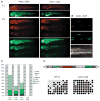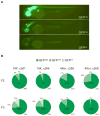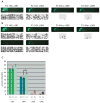Transgenerational analysis of transcriptional silencing in zebrafish
- PMID: 21223961
- PMCID: PMC3065955
- DOI: 10.1016/j.ydbio.2011.01.002
Transgenerational analysis of transcriptional silencing in zebrafish
Abstract
The yeast Gal4/UAS transcriptional activation system is a powerful tool for regulating gene expression in Drosophila and has been increasing in popularity for developmental studies in zebrafish. It is also useful for studying the basis of de novo transcriptional silencing. Fluorescent reporter genes under the control of multiple tandem copies of the upstream activator sequence (UAS) often show evidence of variegated expression and DNA methylation in transgenic zebrafish embryos. To characterize this systematically, we monitored the progression of transcriptional silencing of UAS-regulated transgenes that differ in their integration sites and in the repetitive nature of the UAS. Transgenic larvae were examined in three generations for tissue-specific expression of a green fluorescent protein (GFP) reporter and DNA methylation at the UAS. Single insertions containing four distinct upstream activator sequences were far less susceptible to methylation than insertions containing fourteen copies of the same UAS. In addition, transgenes that integrated in or adjacent to transposon sequence exhibited silencing regardless of the number of UAS sites included in the transgene. Placement of promoter-driven Gal4 upstream of UAS-regulated responder genes in a single bicistronic construct also appeared to accelerate silencing and methylation. The results demonstrate the utility of the zebrafish for efficient tracking of gene silencing mechanisms across several generations, as well as provide useful guidelines for optimal Gal4-regulated gene expression in organisms subject to DNA methylation.
Copyright © 2011 Elsevier Inc. All rights reserved.
Figures





References
-
- Amsterdam A, Lin S, Hopkins N. The Aequorea victoria green fluorescent protein can be used as a reporter in live zebrafish embryos. Dev Biol. 1995;171:123–9. - PubMed
-
- Aramaki S, Hatta K. Visualizing neurons one-by-one in vivo: optical dissection and reconstruction of neural networks with reversible fluorescent proteins. Dev Dyn. 2006;235:2192–9. - PubMed
-
- Boby T, Patch AM, Aves SJ. TRbase: a database relating tandem repeats to disease genes for the human genome. Bioinformatics. 2005;21:811–6. - PubMed
Publication types
MeSH terms
Substances
Grants and funding
LinkOut - more resources
Full Text Sources
Other Literature Sources
Molecular Biology Databases
Research Materials

